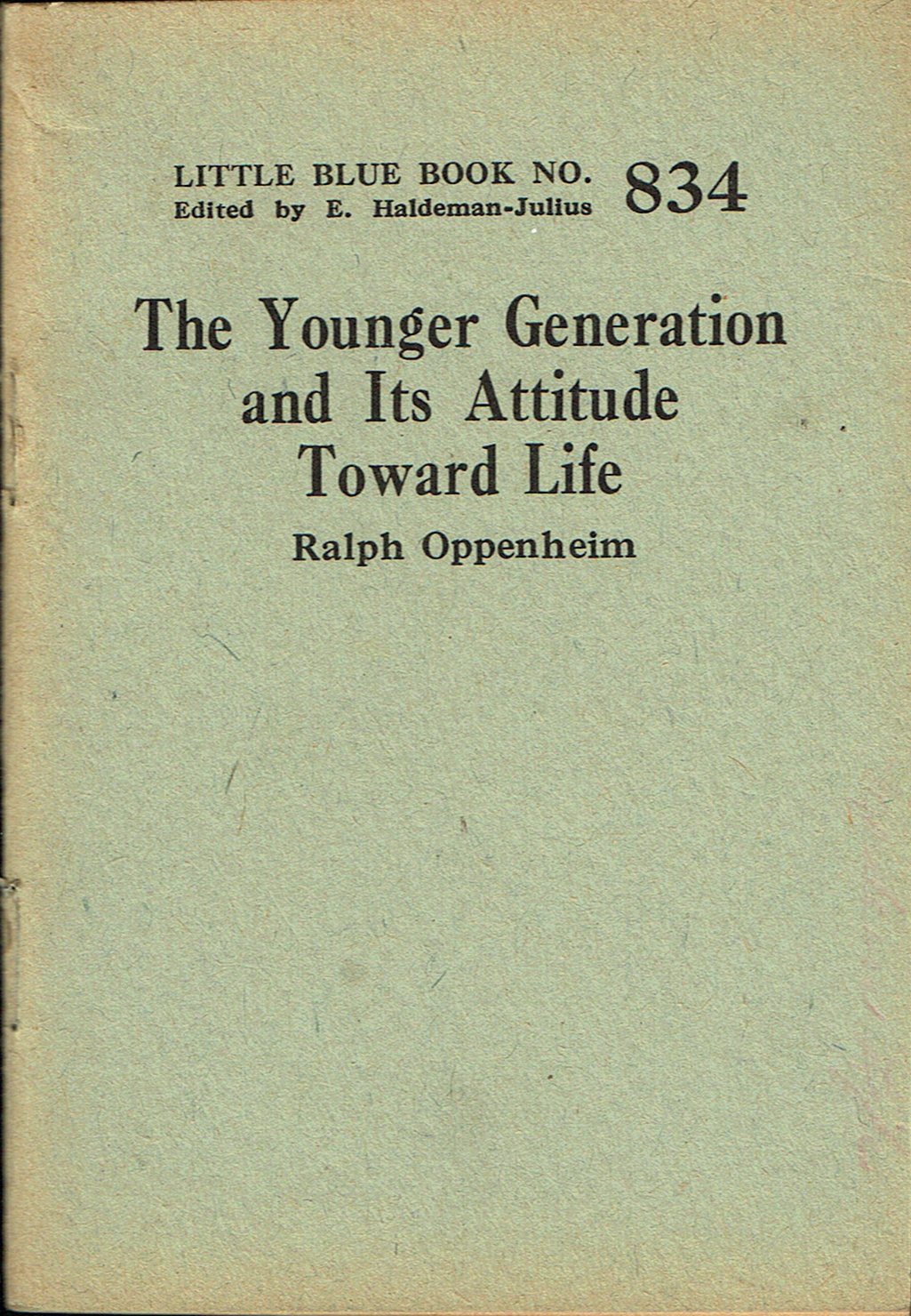Ralph Oppenheim—Boy Biographer
I’VE been researching Ralph Oppenheim, creator and author of The Three Mosquitoes, for six years or so now and I’m always thrilled when a new lead shows up. Recently I did my usual Oppenheim search on newspapers.com to see if anything would show up in any new papers they had added since the last time I had searched. Lo and behold, there were a number of new search results with the top ones being from newspapers dating from 1926 and showing “Ralph Oppenheim—Boy Biog” in the preview window!

These new entries were all from the Haldeman-Julius Weekly. I clicked the link. The Haldeman-Julius Weekly was a 4 page weekly newspaper that was, in fact, an ad for Haldeman-Julius’ library of Little Blue Books with articles and ads for current and upcoming publications. Foremost among the upcoming publications was their new literary quarterly journal (they were also starting up a monthly to help cover all their bases). It was in the ad for the new Haldeman-Julius Quarterly that they referenced Ralph Oppenheim as a “Boy Biographer.”
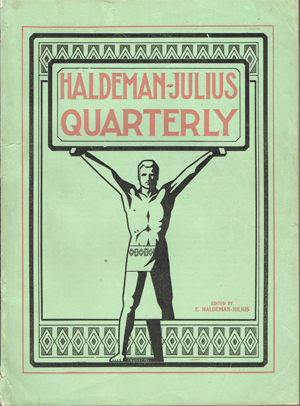 The premiere issue of the Quarterly (October 1926) featured many articles from current and upcoming publications, including Ralph’s “The Love-Life of George Sand.” In some of the early press for the article, they refer to Ralph as being sixteen years old—and, although he could have written it when he was sixteen—he most likely wrote it when he was eighteen, since the hype for it started before he turned nineteen. Ralph’s “The Love-Life of George Sand” article is actually just a reprinting of the 64 page little blue book of the same name. Both the Little Blue Book and the Quarterly were published in 1926.
The premiere issue of the Quarterly (October 1926) featured many articles from current and upcoming publications, including Ralph’s “The Love-Life of George Sand.” In some of the early press for the article, they refer to Ralph as being sixteen years old—and, although he could have written it when he was sixteen—he most likely wrote it when he was eighteen, since the hype for it started before he turned nineteen. Ralph’s “The Love-Life of George Sand” article is actually just a reprinting of the 64 page little blue book of the same name. Both the Little Blue Book and the Quarterly were published in 1926.
|
|
One big difference between the Quarterly and Little Blue Book versions is in the illustrations. The Little Blue Book is not illustrated, while the Quarterly version is profusely illustrated. Foremost among them is A full page portrait of George Sand drawn by Gertrude Oppenheim, Ralph’s Step-Mother. Fred C. Rodewald provided the spot illustrations that pepper the remaining pages of the article.
|
|
But, better yet, from the research angle, the article starts with a full page introduction for it’s author—complete with a photo of the nineteen year old Ralph Oppenheim! So let’s meet Ralph Oppenheim, boy biographer. . . .
Ralph Oppenheim
THE author of “The Love-Life of George Sand” is nineteen years old. Here is one of America’s future authors already at work, beginning to express himself with freshness and vigor, with finish and style; an artist to the tips of his fingers. It is one of the purposes of the Quarterly to bring out the best work of young America, and in accepting Ralph Oppenheim’s study we believe we are giving space to material of first-rate significance. This essay compares favorably with the best work we have ever accepted from mature, experienced writers. We did not take Ralph Oppenheim’s manuscript because he happens to be only a boy in years; rather were we influenced by the sureness of his touch. His age came up for comment only after we were satisfied that his work was well done. . . The Quarterly boasts that all in America is not jazz, noise and fury; a minority speaks vigorously and clearly, with intelligence, understanding, humor and craftsmanship. Ralph’s essay helps prove this assertion. Read young Oppenheim’s study and you will realize how important it is for the United States to have a magazine the purpose of which will be to go out and seek for the best from the talented and intelligent minority, bringing out new gifts, fresh viewpoints and sound work. First credit must, of necessity, go to Ralph himself; second credit must go to his artist-mother, Gertrude Oppenheim, and his poet father, James Oppenheim; third credit, in all fairness, must go to the Quarterly for opening its columns to a new voice. America will hear much from Ralph Oppenheim. He has something to say; he knows how to say it; he is a civilized human being, a complete answer to the charge that all of America has been reduced to stifling mediocrity, to unimaginative standardization. There is enough to complain about, in all truth, without crying that all is lost. Let us protest against the viciousness and stupidity of the superstitious majority, the hypocrisy and cowardice of its leaders, the mawkishness of our bunk-ridden millions—yes, let us aim our spitballs at our shams and fakirs, but let us, by all means, recognize worthy talent when we see it and lend an ear to the emerging youngsters who are breaking away from the herd and learning to stand as free individuals. Turn now to Ralph’s essay. At first you will marvel that it was written by a boy, but after a few paragraphs you will forget its author and fly along with his tonic and captivating work. . . . The portrait of George Sand was drawn especially for the Quarterly by Mrs. James Oppenheim, Ralph’s mother.
According to the ads in the Weekly for the the Quarterly, Oppenheim’s George Sand article proved very popular with the readers and was highly promoted each week in ads for the first issue of the Quarterly. This popularity led to another of Oppenheim’s books being included as an article in the second issue.
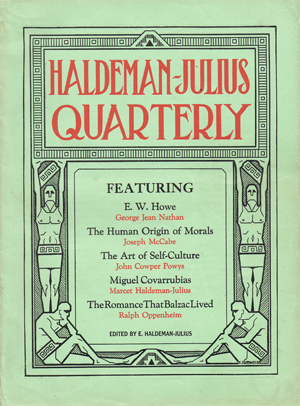 The second issue of the Haldeman-Julius Quarterly (January 1927) featured Oppenheim’s “The Romance That Balzac Lived: How The Great Interpreter of the Human Comedy Lived and Loved” (a reprinting of The Romance That Balzac Lived: Honore de Balzac and the Women He Loved (lbb-1213, 1927)). The article was nicely illustrated with a daguerreotype of Balzac and spot illustrations by Fred C. Rodewald, but no introductory page about Oppenheim.
The second issue of the Haldeman-Julius Quarterly (January 1927) featured Oppenheim’s “The Romance That Balzac Lived: How The Great Interpreter of the Human Comedy Lived and Loved” (a reprinting of The Romance That Balzac Lived: Honore de Balzac and the Women He Loved (lbb-1213, 1927)). The article was nicely illustrated with a daguerreotype of Balzac and spot illustrations by Fred C. Rodewald, but no introductory page about Oppenheim.
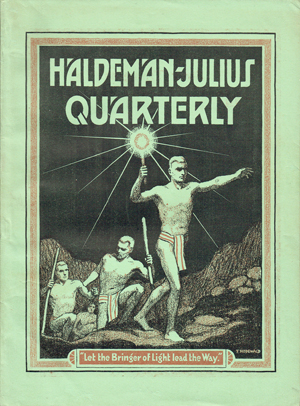 Oppenheim seemed to be a role with the Haldeman-Julius Quarterly readers (or at least their editors), for the third issue (April 1927) once again featured an article by Oppenheim. This time it was his treatise on his generation: “The Younger Generation Speaks: An American Youth Tells About Its Attitude Toward Life” (a reprinting of The Younger Generation and Its Attitude Toward Life (lbb-834, 1927)). In addition to numerous spot illustrations and photos, the article also featured an introduction to the author, once again using the same photo of Oppenheim as before.
Oppenheim seemed to be a role with the Haldeman-Julius Quarterly readers (or at least their editors), for the third issue (April 1927) once again featured an article by Oppenheim. This time it was his treatise on his generation: “The Younger Generation Speaks: An American Youth Tells About Its Attitude Toward Life” (a reprinting of The Younger Generation and Its Attitude Toward Life (lbb-834, 1927)). In addition to numerous spot illustrations and photos, the article also featured an introduction to the author, once again using the same photo of Oppenheim as before.
The Spokesman of Youth
RALPH OPPENHEIM, the young writer who lives in New York—in storied Washington Square, with his father, James Oppenheim—is, in this issue of the Quarterly, a spokesman for American youth. Ralph Oppenheim is someone to be reckoned with, for he is a part of the younger generation in America and one of its thinkers who is now standing up to speak for it with a voice that surely must be heard. Ralph does not idealize and he is not enough of a cynic to color his assertions too much on the bitter side. He looks at youth and their present attitude toward modern life with clear eyes, and makes a fair estimate of what youth is doing and what may be expected from the young people who will soon be leaders among us. Some of the things that this young man has to say about himself and his fellows are harsh, and some of them are quite complimentary, but through all of his work you can depend upon it that Ralph Oppenheim is deeply sincere. Although not yet twenty, Ralph’s viewpoint has the compelling tone of maturity: he is not to be idly brushed aside as of no consequence. You will find that what he has to say is well worth reading, and considering; you will find yourself agreeing and disagreeing with him, and giving a great deal of thought to the ideas and facts which he offers you—and the degree of attention which you will give his work will after all be the best test of Ralph Oppenheim’s success as a spokesman for his generation.
By the time this third issue hit the stands, Oppenheim had already published five titles in Haldeman-Julius’ line of Little Blue Books and had switched gears—writing tales of daring pilots in the hell-skies of The Great War from his attic room in the House of Genius!
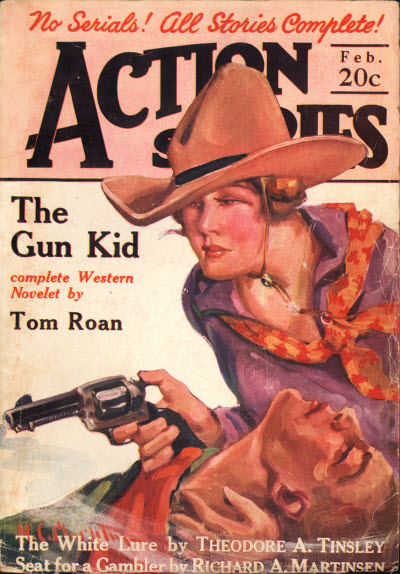 His first published story was a taunt tale of aviation and death he titled “Doom’s Pilot” in the pages of the February 1927 Action Stories! His second printed story—”A Parachutin’ Fool”—was another aviation tale, printed in the April 1927 issue of War Stories! He followed this up with—”Aces Down!”—in the July 1927 issue of War Stories—this was the story that introduced the world to that inseparable trio—The Three Mosquitoes!
His first published story was a taunt tale of aviation and death he titled “Doom’s Pilot” in the pages of the February 1927 Action Stories! His second printed story—”A Parachutin’ Fool”—was another aviation tale, printed in the April 1927 issue of War Stories! He followed this up with—”Aces Down!”—in the July 1927 issue of War Stories—this was the story that introduced the world to that inseparable trio—The Three Mosquitoes!
The rest—as they say—is history.
Here is a facsimile copy of Ralph Oppenheim’s article on “The Love-Life of George Sand” from the premier issue of the Haldeman-Julius Quarterly:
- Download “The Love-Life of George Sand“ (October 1926, Haldeman-Julius Quarterly)








